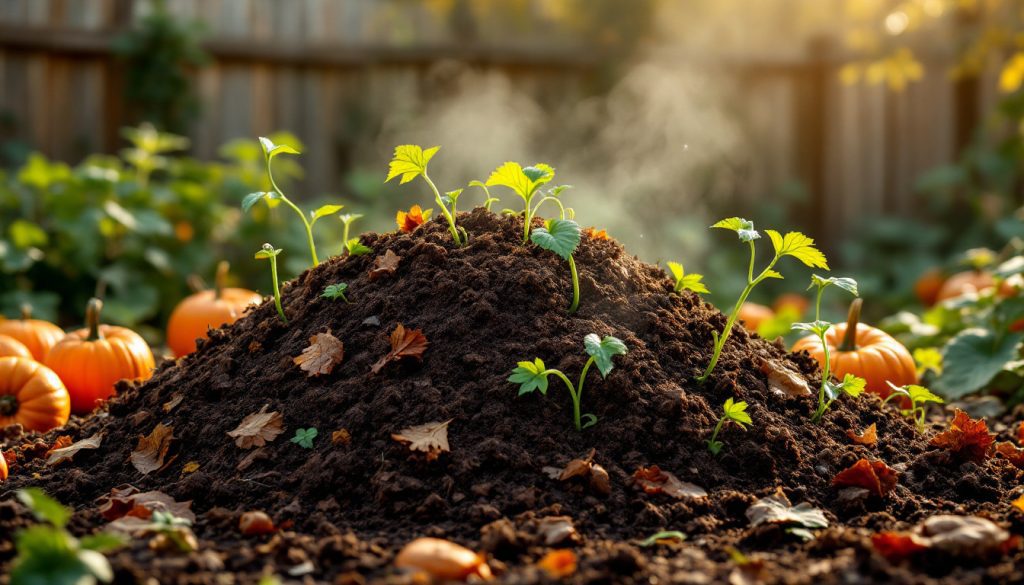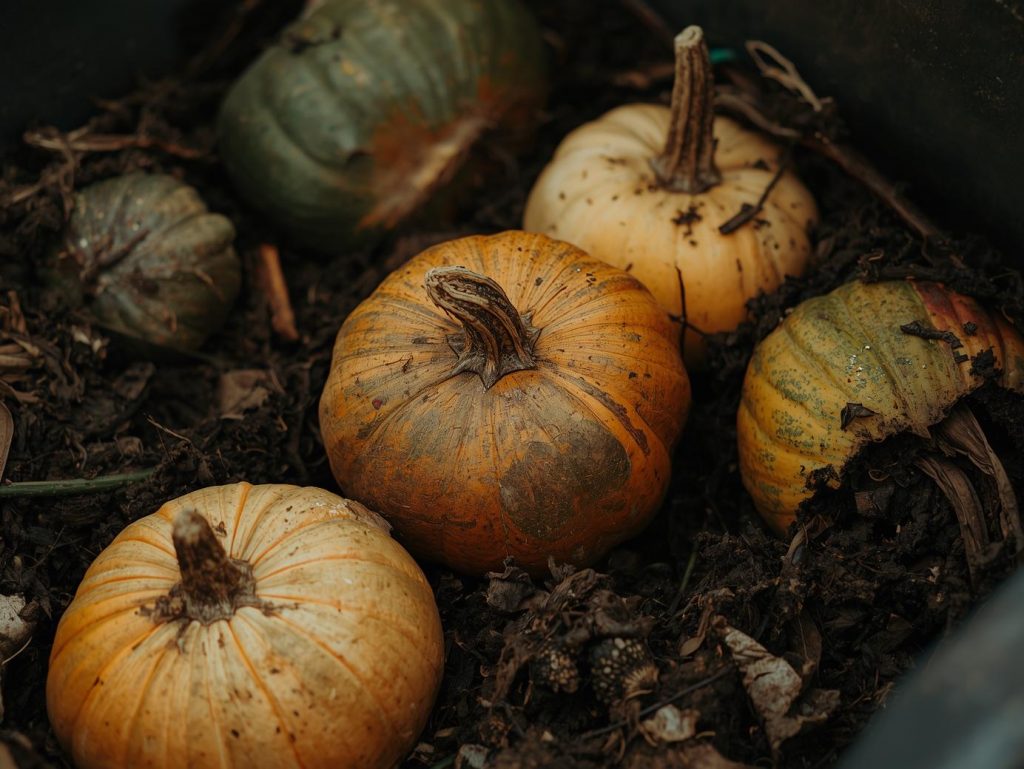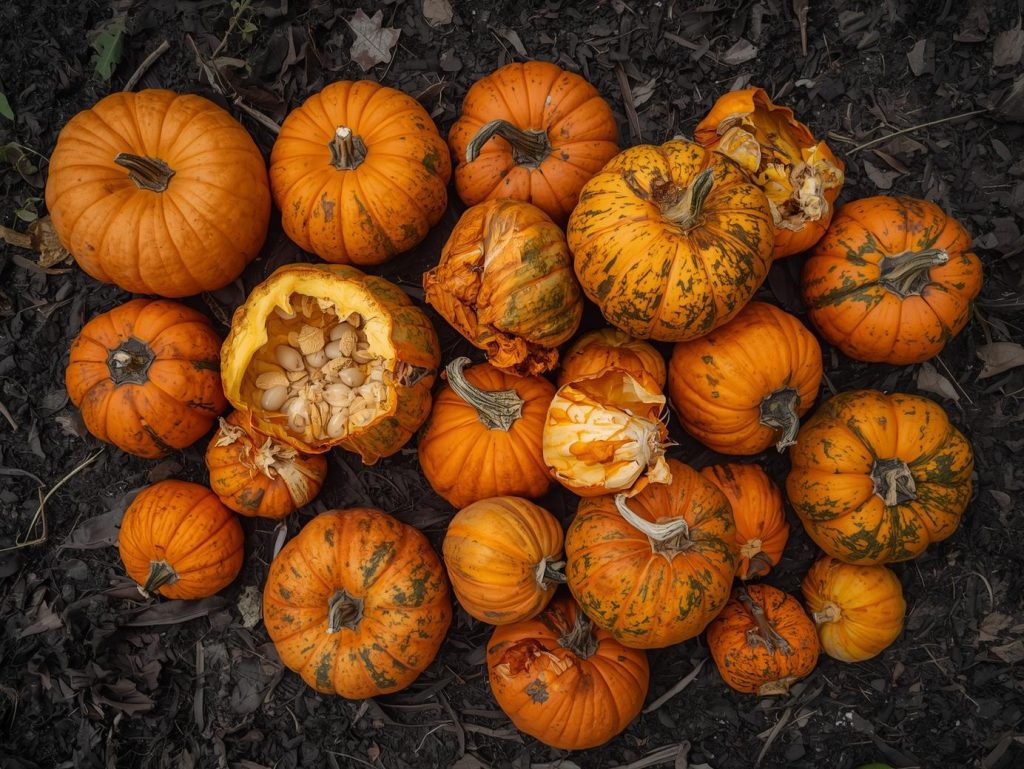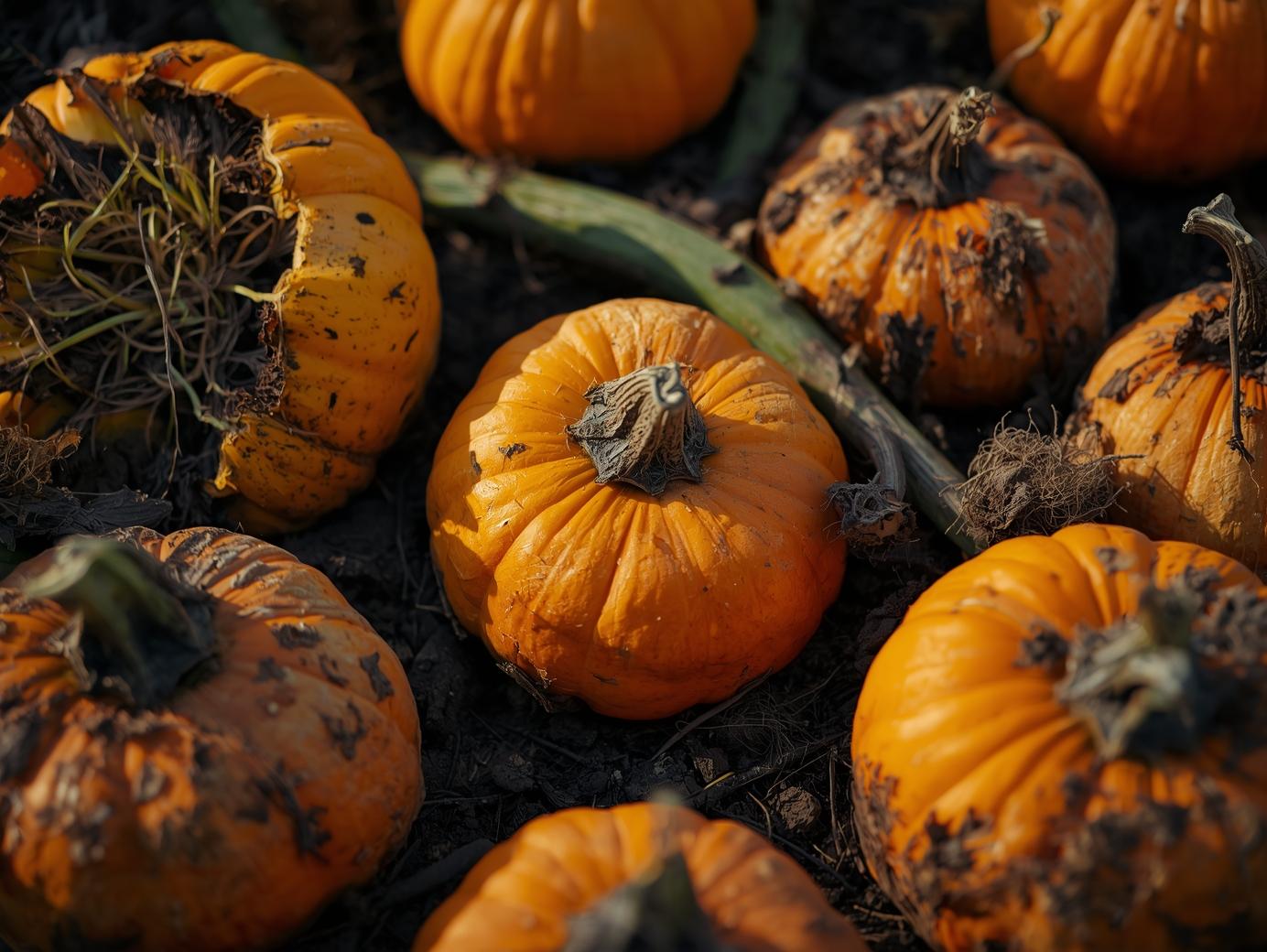How to Grow Bigger, Healthier Squash
Learn Compost for Pumpkins tips, simple recipes, and timing that boost vines. See what to add, what to skip, and how to feed big, healthy fruit.
Big, bright pumpkins start with happy soil, and compost is the secret sauce. Composting means turning vegetable scraps and yard waste into rich, crumbly soil food.
It matters because it recycles waste, cuts landfill trash by reducing methane greenhouse gas emissions, and feeds your pumpkins the nutrients they need for strong vines and plump fruits.
Think of compost as a balanced soil amendment for your pumpkin patch. It improves soil structure, holds moisture during dry spells, and releases nutrients steadily.
Your plants grow deeper roots, set more flowers, and fill out fruits with fewer hiccups.
Getting started is easy. Save vegetable scraps, coffee grounds, and autumn leaves, then mix them in a bin and add moisture.
Turn piles regularly to bring in air, and you’ll see dark, earthy compost ready to spread around your young pumpkin plants.
Short on space? Use a compost tumbler or compost bins for quick, tidy batches on a patio, or try vermicomposting with red wigglers in a small bin.
Worm castings add a gentle nutrient boost and helpful microbes that pumpkins love.
Even a balcony gardener can make enough to topdress a container-grown pumpkin.
This simple habit fits a greener lifestyle. Every scoop keeps food scraps out of the bin and builds life in your soil.
Start small, stay consistent, and watch your vines thrive with satisfyingly heavy fruits.

Why Use Compost to Grow Amazing Pumpkins?
Compost turns everyday scraps into slow, steady pumpkin fuel. It feeds vines, keeps roots cool, and builds soil that holds water like a sponge.
If you are new to making your own mix, try these simple steps in our guide to starting composting at home.
Homemade compost supports organic growth and cuts garden waste at the same time.
Nutrients Pumpkins Love from Compost
Pumpkins are hungry plants. Compost offers a balanced menu so they can grow long vines and fill out big fruits.
- Nitrogen: Found in nitrogen-rich materials like veggie scraps, coffee grounds, and fresh grass clippings. Nitrogen pushes leafy growth, which means more vine length and more leaf area for photosynthesis. Strong vines set the stage for bigger pumpkins.
- Phosphorus: Released from well-rotted leaves, banana peels, and bone meal if you add it to your pile. Phosphorus helps roots grow deep and firm, then supports flower and fruit development. Better roots, better fruit set.
- Potassium: Comes from autumn leaves, fruit peels, and wood ash used sparingly.
- Potassium improves water movement in the plant and strengthens cell walls. That leads to firm, nicely shaped pumpkins with good color.
Compost does more than a quick hit of feed. It releases nutrients bit by bit, so your pumpkins do not boom and bust.
That slow release keeps growth steady, reduces stress, and supports clean, organic gardening.
If you want to make compost faster, explore the 6 effective composting methods and pick one that fits your space.
Quick example: a heap built from kitchen peels, coffee grounds, and carbon-rich materials like shredded leaves gives a balanced N-P-K base.
Top it off with a little aged manure for extra nitrogen if you have access, then let time and microbes do the mixing.
How Compost Makes Soil Better for Pumpkins
Compost transforms average soil into a pumpkin-friendly bed.
- Improved texture: It loosens heavy clay and firms up sandy soil. Roots can wiggle through and reach water and nutrients without strain.
- Moisture retention: Compost acts like a sponge. It holds water during dry spells, then releases it slowly to the roots. That means fewer swings between soggy and dry.
- Microbe activity: Healthy compost teems with tiny helpers. These microbes break down organic matter into plant-ready food and help protect roots from stress.
Before planting, mix 2 to 3 inches of aged compost into the top 6 to 8 inches of your bed.
Aged compost is cool to the touch, smells earthy, and looks dark and crumbly.
After vines start running, add a thin compost mulch around plants to lock in moisture and keep weeds low.
End of season tip: compost your post-Halloween pumpkins and spent vines to cycle nutrients back into next year’s patch.
Local programs also explain safe pumpkin recycling, like this overview on pumpkin composting.
Key takeaways:
- Compost feeds pumpkins with steady nitrogen, phosphorus, and potassium.
- It improves soil structure, water holding, and root health.
- Mix in 2 to 3 inches of aged compost before planting for a strong start.
- Homemade compost supports organic growth and cuts waste.

How to Prepare and Apply Compost for Your Pumpkin Plants
Compost gives pumpkins steady food, better moisture, and a softer bed for roots.
Set things up right at planting, then keep topping up through the season. Here is a simple plan that works in small gardens and big patches alike.
Choosing and Preparing Your Compost
Look for signs your compost is finished. It should be dark, crumbly, and cool to the touch.
A healthy, earthy smell means microbes did their job. If it looks streaky, feels sticky, or smells sour, give it more time or use it only on the surface.
Aim for a good balance when you make your pile. Mix plenty of carbon-rich materials with your nitrogen-rich materials.
A simple rule is about 2 to 3 parts carbon-rich materials (leaves, straw, cardboard) to 1 part nitrogen-rich materials (veg scraps, coffee grounds, grass).
If you want a tidy, mess-free method, the step-by-step compost layering technique keeps smells down and speeds results.
Unfinished material is not a deal breaker for pumpkins. These pumpkin plants are tough and often handle semi-finished stuff, especially with trench composting along the rows to integrate it gradually.
Still, keep it as a mulch, not in the seed zone. Spread it on top and let worms do the mixing for you.
Pick out big sticks, and aim for moisture like a wrung-out sponge.
Quick prep tips:
- Sieve or hand-pick woody bits for smoother spreading.
- Avoid pet waste, glossy paper, or treated wood chips.
- Store a sack of dry leaves to fix wet, heavy piles before use.
Planting Pumpkins in Compost-Enriched Soil
Build low hills so roots warm up, drain well, and spread. Pumpkins love rich soil with material mixed in.
Follow these steps:
- Make a hill 60 to 90 cm wide, about 15 cm high. Blend in 2 to 3 inches of finished compost directly in garden through the top 15 to 20 cm of soil. For soil basics and timing, the RHS guide on how to grow pumpkins is a handy reference.
- Form a shallow bowl at the top to hold water. This keeps moisture near the roots.
- Sow seeds 1 inch deep, 3 seeds per hill. Thin to the strongest one or two seedlings later.
- Space hills 4 to 6 feet apart for compact types, wider for large varieties.
- Water deeply right after sowing. Keep soil evenly moist, not soggy.
- When seedlings have two true leaves, add a light ring of material around the hill and water again.
Soil still feels tight or sandy? See these simple ways for using compost to improve soil texture and water holding as a soil amendment.
Maintaining Your Patch with Compost
A little material mid-season keeps vines strong without harsh spikes. Add a 1 to 2 inch top-dress when vines start running.
Keep mulch a few centimeters away from stems to prevent rot.
Side-dress along the vines as fruits set:
- Add a narrow band of material on each side of the vine.
- Water to move nutrients into the root zone.
- Repeat lightly every 3 to 4 weeks until fruits size up.
Keep an eye out for pests, and use gentle tactics first. Check leaf undersides, hand-pick where you can, and keep plants stress-free with steady moisture.
For a practical feeding rhythm and general care tips, see GrowVeg’s guide on how to grow pumpkins.
Smart maintenance tips:
- Use material as mulch to lock in water and reduce weeds.
- Avoid heavy nitrogen late in the season, it pushes leaves over fruit.
- Place a board or straw under fruits to keep them clean and dry.
Key takeaways:
- Finished material looks dark, smells earthy, and feels crumbly.
- Mix 2 to 3 parts carbon-rich materials to 1 part nitrogen-rich materials for a balanced pile.
- Build hills, mix in material, sow 1 inch deep, and space 4 to 6 feet.
- Top-dress mid-season and side-dress vines at fruit set for steady growth.
- Use material as mulch to save water and support healthier pumpkins.

Key Takeaways and FAQ
Use this quick-hit guide to lock in what works for bigger, healthier pumpkins.
Then skim the FAQ for fast fixes to common compost questions.
Keep it simple, stay consistent, and let your compost do the heavy lifting.
Key Takeaways
- Build rich soil first: Mix 2 to 3 inches of finished compost into the top 15 to 20 cm before planting.
- Feed steadily, not heavily: Top-dress with 1 to 2 inches when vines start running, then lightly every 3 to 4 weeks.
- Balance matters: Keep compost inputs near a 2 to 3 parts browns to 1 part greens ratio for clean, earthy compost.
- Moisture is a big deal: Compost should feel like a wrung-out sponge; this keeps roots happy and reduces stress.
- Unfinished compost is okay on top: Use semi-finished compost as mulch, not in the seed zone.
- Manure helps, if aged: Aged manure plus compost gives a strong start for heavy-feeding pumpkins. For a friendly, step-by-step example, see this guide on growing pumpkins the easy way.
- Time applications with the season: Adjust by turning piles regularly, moisture, and layering with weather. Helpful planning ideas live in these seasonal composting tips for thriving bins.
- Recycle what you can: Pumpkin guts, seeds, and spent vines can return to the pile. Learn safe prep in this expert overview on how to compost pumpkins.
Quick FAQ
How much compost should I use per pumpkin plant?
Blend 2 to 3 inches of mature compost into the planting area, then top-dress with 1 inch at vining and again at fruit set.
Can I use unfinished compost?
Yes, as a mulch. Keep unfinished material on the surface and away from stems. Do not bury seeds or roots in it.
What compost ingredients help pumpkins most?
- Greens: coffee grounds, veg scraps, fresh grass, and pumpkin seeds (roasted first to keep pumpkins from sprouting) for nitrogen.
- Browns: shredded leaves, straw, cardboard for structure and airflow. Aim for a loose, crumbly texture so roots can spread.
Do pumpkins like manure?
They love aged manure mixed with compost. Fresh manure can burn roots and invite pests. Use only well-rotted material.
How often should I top-dress?
Every 3 to 4 weeks through mid-season. Ease off once fruits near full size to steer energy into ripening.
Should I use compost tea?
It can help with microbe life on leaves and soil. Use it as a supplement, not a replacement for solid compost.
Can I compost pumpkin guts and vines after Halloween?
Absolutely. You can compost carved pumpkins, uncarved pumpkins, whole pumpkins, cooked pumpkins, and even jack-o-lanterns.
Chop or smash pumpkins to help them break down faster, remove decor like stickers and candles, and mix with dry leaves to prevent a soggy pile.
For extra detail, see how to compost pumpkins. Or check your local community composting program for drop-off options.
What if my soil is sandy or heavy clay?
Compost fixes both. It holds water in sand and improves drainage in clay. Keep adding small amounts each season for lasting change.
Is old potting compost worth reusing?
Yes. Refresh it by blending with new compost, then use it as mulch or a soil conditioner. Here are practical ideas for reusing old container compost in gardens.
Any timing tips for UK gardeners?
Follow the weather. Warm spells speed breakdown, rain can waterlog piles. A simple calendar helps you turn, water, and layer at the right moments. Try these year-round composting calendar strategies.
Summary
- Compost gives steady nutrients, cooler roots, and better moisture balance.
- Start with a rich base, then top-dress through the season.
- Use aged manure with compost for hungry vines.
- Recycle pumpkin waste back into the pile to fuel next year’s patch.
Available on our Etsy Store
Conclusion
Healthy pumpkins start with living soil, and compost keeps that cycle turning.
You feed the bed with a balanced, crumbly mix, the vines reward you with sturdy growth and full fruits, then those post-harvest guts and vines return to the pile.
Simple, tidy, and fun.
Keep your routine light and steady. Mix in mature compost at planting, add a thin mulch as vines run, and refresh lightly at fruit set.
When autumn wraps up, chop the vegetable scraps and fold them back into your bin.
That is how you grow bigger pumpkins while cutting waste at home.
Ready to try a new bin or improve your setup with compost bins? Explore easy, low-fuss ideas for backyard composting with Geobin.
Then experiment, take notes, and share what worked for your patch. What surprised you this season, and what will you tweak next year?
Thanks for reading. Your pumpkins, your soil, and the planet all win when scraps become soil food.
Happy composting and happy harvests.
Key takeaways:
- Compost feeds steadily, improves soil texture, and helps roots stay moist.
- Mix in 2 to 3 inches before planting, then top-dress through the season.
- Use unfinished compost only as mulch, not in the seed or root zone.
- Keep a simple browns-to-greens balance for clean, earthy compost.
- Recycle pumpkin leftovers to fuel next year’s crop with finished compost.






